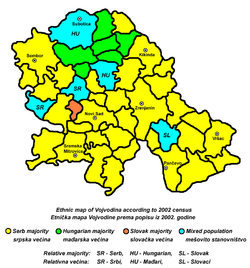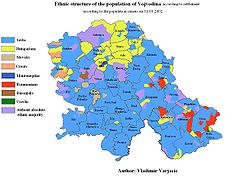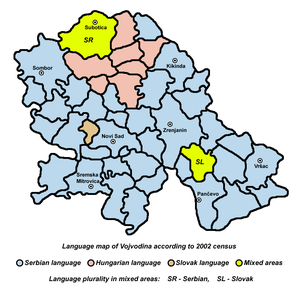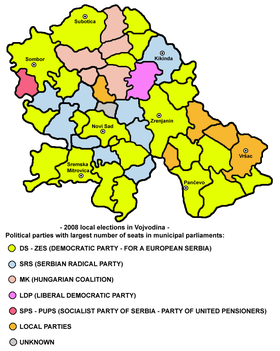
Hungarian Regional Autonomy
Encyclopedia

Serbian language
Serbian is a form of Serbo-Croatian, a South Slavic language, spoken by Serbs in Serbia, Bosnia and Herzegovina, Montenegro, Croatia and neighbouring countries....
: Мађарска регионална самоуправа or Mađarska regionalna samouprava) is the name of a proposed new administrative unit in the northern part of the Autonomous Province of Vojvodina
Vojvodina
Vojvodina, officially called Autonomous Province of Vojvodina is an autonomous province of Serbia. Its capital and largest city is Novi Sad...
, Serbia
Serbia
Serbia , officially the Republic of Serbia , is a landlocked country located at the crossroads of Central and Southeast Europe, covering the southern part of the Carpathian basin and the central part of the Balkans...
. It is a part of the program of the Hungarian Coalition
Hungarian Coalition
The Hungarian Coalition ; Serbian: Мађарска Коалиција , Mađarska Koalicija ) is a political coalition composed of 3 ethnic Hungarian political parties in Serbia: the Alliance of Vojvodina Hungarians, the Democratic Party of Vojvodina Hungarians, and the Democratic Fellowship of Vojvodina Hungarians...
.
Proposal
The creation of this new administrative unit is proposed by the Hungarian CoalitionHungarian Coalition
The Hungarian Coalition ; Serbian: Мађарска Коалиција , Mađarska Koalicija ) is a political coalition composed of 3 ethnic Hungarian political parties in Serbia: the Alliance of Vojvodina Hungarians, the Democratic Party of Vojvodina Hungarians, and the Democratic Fellowship of Vojvodina Hungarians...
, which is composed of three ethnic Hungarian political parties in Serbia: the Alliance of Vojvodina Hungarians
Alliance of Vojvodina Hungarians
The Alliance of Vojvodina Hungarians ; , Savez vojvođanskih Mađara ) is an ethnic Hungarian political party in the Serbian province of Vojvodina. Its chairman is István Pásztor. The former party chairman József Kasza is now its honorary president...
, the Democratic Party of Vojvodina Hungarians, and the Democratic Fellowship of Vojvodina Hungarians
Democratic Fellowship of Vojvodina Hungarians
Democratic Fellowship of Vojvodina Hungarians Democratic Fellowship of Vojvodina Hungarians Democratic Fellowship of Vojvodina Hungarians (Hungarian: Vajdasági Magyarok Demokratikus Közössége (VMDK), Serbian: Демократска заједница војвођанских Мађара (ДЗВМ), Demokratska zajednica vojvođanskih...
. In this proposal, the Hungarian Regional Autonomy would be a separate autonomous region in the northern part of Vojvodina. This autonomous region would include the nine municipalities of northern Vojvodina: Subotica
Subotica
Subotica is a city and municipality in northern Serbia, in the Autonomous Province of Vojvodina...
, Bačka Topola
Backa Topola
Bačka Topola is a town and municipality in the North Bačka District of Vojvodina, Serbia...
, Mali Iđoš, Kanjiža
Kanjiža
Kanjiža is a town and municipality in the North Banat District of Vojvodina, Serbia...
, Senta
Senta
Senta is a town and municipality on the bank of the Tisa river in the Vojvodina province, Serbia. Although geographically located in Bačka, it is part of the North Banat District...
, Ada
Ada, Serbia
Ada is a town and municipality in Serbia. It is situated near the river Tisa in Vojvodina province. Although the town is geographically located in Bačka, it is part of the North Banat District...
, Bečej
Becej
Bečej is a town and municipality located in the South Bačka District in Vojvodina, Serbia. The town has a population of 25,703, while Bečej municipality has 40,877 inhabitants. It is multiethnic town, with Hungarians and Serbs as largest ethnic groups...
, Čoka
Coka
Čoka is a town and municipality in the North Banat District of Vojvodina, Serbia. The town has a population of 4,720, while Čoka municipality has 13,835 inhabitants....
, and Novi Kneževac
Novi Kneževac
Novi Kneževac is a town and municipality in the North Banat District of Vojvodina, Serbia. The town has a population of 7,567, while the Novi Kneževac municipality has 12,952 inhabitants .-Name:...
. The administrative centre of the region would be Subotica, while the region itself would be part of Vojvodina
Vojvodina
Vojvodina, officially called Autonomous Province of Vojvodina is an autonomous province of Serbia. Its capital and largest city is Novi Sad...
and Serbia
Serbia
Serbia , officially the Republic of Serbia , is a landlocked country located at the crossroads of Central and Southeast Europe, covering the southern part of the Carpathian basin and the central part of the Balkans...
. The proposal for the creation of the Hungarian Regional Autonomy is based on the autonomy model of South Tyrol
South Tyrol
South Tyrol , also known by its Italian name Alto Adige, is an autonomous province in northern Italy. It is one of the two autonomous provinces that make up the autonomous region of Trentino-Alto Adige/Südtirol. The province has an area of and a total population of more than 500,000 inhabitants...
in Italy
Italy
Italy , officially the Italian Republic languages]] under the European Charter for Regional or Minority Languages. In each of these, Italy's official name is as follows:;;;;;;;;), is a unitary parliamentary republic in South-Central Europe. To the north it borders France, Switzerland, Austria and...
.
Besides the Hungarian Coalition
Hungarian Coalition
The Hungarian Coalition ; Serbian: Мађарска Коалиција , Mađarska Koalicija ) is a political coalition composed of 3 ethnic Hungarian political parties in Serbia: the Alliance of Vojvodina Hungarians, the Democratic Party of Vojvodina Hungarians, and the Democratic Fellowship of Vojvodina Hungarians...
, some other ethnic Hungarian political parties and movements, like Hungarian Civic Alliance
Hungarian Civic Alliance, Serbia
Hungarian Civic Alliance , Građanski Savez Mađara ) is an ethnic Hungarian political party in Serbia, led by Laslo Rac Sabo.In 2008 local elections in Serbia, the Hungarian Civic Alliance won 13.59% of votes in Senta and two seats in the municipal parliament in Ada....
and 64 Counties Movement also advocating territorial autonomy for ethnic Hungarians in Vojvodina.
Ethnic groups




Serbs
The Serbs are a South Slavic ethnic group of the Balkans and southern Central Europe. Serbs are located mainly in Serbia, Montenegro and Bosnia and Herzegovina, and form a sizable minority in Croatia, the Republic of Macedonia and Slovenia. Likewise, Serbs are an officially recognized minority in...
, 5.31% Croats
Croats
Croats are a South Slavic ethnic group mostly living in Croatia, Bosnia and Herzegovina and nearby countries. There are around 4 million Croats living inside Croatia and up to 4.5 million throughout the rest of the world. Responding to political, social and economic pressure, many Croats have...
, 4.87% Bunjevci
Bunjevci
Bunjevci are a South Slavic community and ethnic group living mostly in the Bačka region of Serbia and southern Hungary...
, 3.50% Yugoslavs
Yugoslavs
Yugoslavs is a national designation used by a minority of South Slavs across the countries of the former Yugoslavia and in the diaspora...
, 1.69% Montenegrins, 1.34% Roma, and others.
60.40% of all Hungarians living in Serbia and 61.04% of all Hungarians living in Vojvodina would live within the borders of the proposed region.
The ethnic composition of the municipalities, which are supposed to be included into region look as follows:
The municipalities with Hungarian ethnic majority are: Kanjiža (86.52%), Senta (80.51%), Ada (76.64%), Bačka Topola (58.94%), Mali Iđoš (55.92%), and Čoka (51.56%).
The Novi Kneževac municipality has a Serb ethnic majority (59.53%).
The municipalities of Subotica and Bečej are ethnically mixed. The population of Subotica municipality is composed of 38.47% Hungarians, 24.14% Serbs, 11.24% Croats, 10.95% Bunjevci, 5.76% Yugoslavs, 1.25% Montenegrins, etc. The population of Bečej municipality is composed of 48.83% Hungarians, 41.06% Serbs, 2.61% Yugoslavs, 1.16% Roma, 1.06% Croats, etc.
Controversy
The creation of the Hungarian Regional Autonomy with proposed regional borders is a controversial issue. If the new region is supposed to be created by the democratic consensus and free voluntary association of the municipalities, it is very unlikely that the citizens of the predominantly Serb municipality of Novi Kneževac would vote to join their municipality to the Hungarian Regional Autonomy.The question also is how would vote the majority of the citizens of the ethnically mixed municipalities of Subotica and Bečej, since the ethnic Hungarians make up less than 50% of population in these municipalities. For example, in the municipality of Subotica, the proposed administrative centre of the new region, only 38.47% of the population are ethnic Hungarians, while 53.36% of the population are various South Slavic ethnic groups, which speak Serbian
Serbian language
Serbian is a form of Serbo-Croatian, a South Slavic language, spoken by Serbs in Serbia, Bosnia and Herzegovina, Montenegro, Croatia and neighbouring countries....
or Croatian language
Croatian language
Croatian is the collective name for the standard language and dialects spoken by Croats, principally in Croatia, Bosnia and Herzegovina, the Serbian province of Vojvodina and other neighbouring countries...
.
Another problem regarding regional autonomy proposals are demographic trends in the area. The current proposal is based on demographic data from last population census in 2002, which put percent of Hungarians in the area at 52.10% and percent of Serbs at 25.74%. However, these demographic relations will probably change drastically in the next few decades. According to the 1991 census, the total population of this area (including all 9 municipalities) numbered 358,126 people, of whom 202,205 (56.46%) were ethnic Hungarians and 67,392 (18.82%) were ethnic Serbs. In 2002, the total population of the area was 340,006, of whom 177,143 (52.10%) were ethnic Hungarians and 87,499 (25.74%) were ethnic Serbs. Differences between two censuses show decrease of Hungarian and increase of Serb population in the area. If same demographic trends continue in the following time period, the next population census (in 2011) will show that Hungarians are no longer absolute but only relative majority in the area, while in 2020-2030 Serbs will replace Hungarians as the largest ethnic group in the area, hence it is hard to believe the majority of local inhabitants who will live in this area in 2020-2030 (or even in 2010) would support regional autonomy proposal. There is also a question whether regional autonomy that would be established right now could prevent decline of Hungarian population in the area. The examples from municipalities such are Subotica or Bečej show that no matter that these municipalities were under ethnic Hungarian local administration, the number of Hungarians in these areas declined.
Some argue that the steep decrease of Hungarian population and parallel growth of Serbian population experienced between 1991 and 2000 would not be so large between 2001 and 2010, as this phenomenon was partially fueled by the various armed conflicts that emerged on the territory of Yugoslavia between 1991 and 2000. More specifically, a mass emigration of young ethnic Hungarian men could be observed following the outbreak of the conflicts, whose purpose was mainly to avoid military service in the Yugoslav army. Also, the largely ethnic reasons of the Yugoslav wars made many ethnic Hungarians feel insecure about their future in Serbia and, together with the ensuing economic regression, convinced them to opt for emigration to Hungary. On the other hand, the strong increase of Serbian population in the region is partially due to the settlement of Serbs that fled Croatia, Bosnia and Kosovo after the Yugoslav army or Serbian dominated militias had lost control over these territories. However, the previous period from 1948 to 1991, before the Yugoslav conflicts emerged, also show decrease of Hungarian and increase of Serbian population (428,932 Hungarians in Vojvodina in 1948 and 340,946 Hungarians in Vojvodina in 1991, 841,246 Serbs in Vojvodina in 1948 and 1,151,353 Serbs in Vojvodina in 1991). Therefore, even if not so fast, the further decrease of Hungarian population in Vojvodina is expected (Similar decrease of Hungarian population is also present in Slovakia and Romania, i.e., in countries that did not experienced armed conflicts and mass influx of refugees).
Support for the idea

Serbian local elections, 2008
Local elections were held in Serbia on 11 May 2008. According to the Constitutional Law adopted by the National Assembly on 30 September 2006 that proclaimed the new constitution, the parliamentary Speaker had to schedule the elections for local administrative units by 31 December 2007. He...
, the expectations of the Hungarian Coalition were to won majority of votes in the local parliaments of municipalities of Serbia with ethnic Hungarian majority, but this was the case only in municipality of Kanjiža
Kanjiža
Kanjiža is a town and municipality in the North Banat District of Vojvodina, Serbia...
, where Hungarian Coalition won 50.91% of votes. The Coalition also won the plurality of votes in municipalities of Senta
Senta
Senta is a town and municipality on the bank of the Tisa river in the Vojvodina province, Serbia. Although geographically located in Bačka, it is part of the North Banat District...
(31.87%), Bačka Topola
Backa Topola
Bačka Topola is a town and municipality in the North Bačka District of Vojvodina, Serbia...
(46.25%), and Mali Iđoš (37.18%), while in municipalities of Čoka
Coka
Čoka is a town and municipality in the North Banat District of Vojvodina, Serbia. The town has a population of 4,720, while Čoka municipality has 13,835 inhabitants....
and Ada
Ada, Serbia
Ada is a town and municipality in Serbia. It is situated near the river Tisa in Vojvodina province. Although the town is geographically located in Bačka, it is part of the North Banat District...
, the Hungarian Coalition was second largest political option, after Democratic Party
Democratic Party (Serbia)
The Democratic Party is a political party in Serbia. It is described as a social liberal or social democratic party.-Pre-war history:The Democratic Party was established on 16 February 1919 from unification of Sarajevo parties independent radicals, progressives, liberals and the Serbian part of...
(In Čoka, Democratic Party won 29.08% of votes and Hungarian Coalition won 24.47% of votes; in Ada, the coalition led by Democratic Party won 29.25% of votes and Hungarian Coalition won 25.70% of votes). In ethnically mixed municipality of Subotica
Subotica
Subotica is a city and municipality in northern Serbia, in the Autonomous Province of Vojvodina...
, the Hungarian Coalition was also second largest political option after coalition led by Democratic Party (Democratic Party coalition won 40.16% of votes and Hungarian Coalition won 27.14% of votes in Subotica), while in ethnically mixed municipality of Bečej
Becej
Bečej is a town and municipality located in the South Bačka District in Vojvodina, Serbia. The town has a population of 25,703, while Bečej municipality has 40,877 inhabitants. It is multiethnic town, with Hungarians and Serbs as largest ethnic groups...
, the Hungarian Coalition won the plurality of votes (29.63%). In municipality of Novi Kneževac
Novi Kneževac
Novi Kneževac is a town and municipality in the North Banat District of Vojvodina, Serbia. The town has a population of 7,567, while the Novi Kneževac municipality has 12,952 inhabitants .-Name:...
with ethnic Serb majority (claimed by Hungarian Coalition as part of future autonomous region), the Hungarian Coalition was third largest political option with 17.63% of votes (Largest political option in Novi Kneževac municipality was coalition led by Democratic Party with 27.18% of votes, and second largest was Serbian Radical Party
Serbian Radical Party
The Serbian Radical Party is a far-right Serbian nationalist political party in Serbia, founded in 1991. Currently the second-largest party in the Serbian National Assembly, it has branches in three of the nations that currently border Serbia – all former federal republics of Yugoslavia...
with 22.46% of votes). http://www.cesid.org/rezultati/sr_maj_2008-lokalni/index.jsp
External links
- Mađarska regionalna samouprava (in Serbian)
- Magyar körzeti önkormányzat (in Hungarian)

